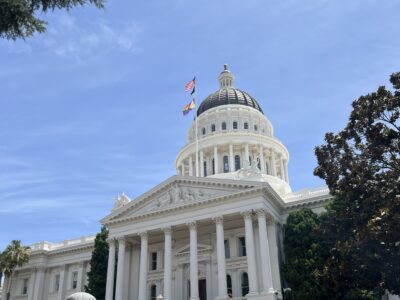CEQA and UC Berkeley Housing: Don’t Panic
The decision blocking student housing hardly represents new NIMBY weaponization.

(Photo Credit: Library of Congress)
Lots of screaming and yelling about last week’s Court of Appeal CEQA decision concerning student housing at UC Berkeley. The Court struck down the university’s plan for more student housing on the grounds that the final Environmental Impact Report did not adequately assess noise impacts from students.
“The campus is dismayed by this unprecedented and dangerous decision to dramatically expand CEQA, and the campus will ask the California Supreme Court to overturn it,” the school said in a statement.
“Left in place, this decision will indefinitely delay all of UC Berkeley’s planned student housing, which is desperately needed by our students and fully supported by the City of Berkeley’s mayor and other elected representatives,” the statement said. “This decision has the potential to prevent colleges and universities across the State of California from providing students with the housing they need and deserve.”
The campus also said the ruling “bestows new privileges and power to the privileged and powerful by arming NIMBY neighbors with additional weapons to obstruct the development of all new urban housing, impeding the construction of housing not just for students but also for the unhoused and low-income families.”
“This would make CEQA a dangerous and powerful tool for any neighbor that does not like the social habits and customs of potential new residents,” Nicole Gordon of the Sohagi Law Group, which is representing UC, argued in a Jan. 3 letter to the court. “It is unfortunately easy to imagine this new ‘CEQA impact’ being applied to perpetuate prejudice and stereotypes.”
Governor Newsom, last seen destroying good climate policy to satisfy his donors, has weighed in as well. “Our CEQA process is clearly broken when a few wealthy homeowners can block desperately needed student housing for years and even decades.
Calm down. This isn’t a good decision, but it isn’t an awful one, either. It shows a Court trying to figure things out: while it could have been more creative, and the statute is badly flawed, the biggest problem comes from the university, which basically didn’t do its homework.
The Court essentially upheld the University’s position on all major issues save one, i.e. the prospect of new student housing creating noise impacts on neighbors.
The biggest problem, as the Court explained, is that the University didn’t analyze anything about the possibility of excessive noise coming from new student housing. It just dismissed it as speculative.
And opponents of the decision are jumping on this, saying that the we could get any amount of studies saying that any demographic group makes more noise.

The problem with that argument is that the University had already conceded that there might be something of a noise problem. And this really is common sense: what? Student housing causing noise problems? I’m shocked!! Call Captain Renault!
This wasn’t a prospect invented by the neighbors: it was acknowledged by the University and the subject of an ordinance from the City of Berkeley itself. And then the University just chose not to deal with it in the EIR. That’s on the University, not CEQA.
Note also that CEQA doesn’t even require the University to solve a potential student noise problem: it can issue a “Statement of Overriding Considerations” stating why student housing is more important than the noise impacts. If backed by “substantial evidence” in the record – which in this case would not be difficult – it would win. Essentially, the University didn’t want to deal with acknowledging the problem: again, that’s not CEQA’s fault.
That said, the decision – and CEQA itself – is problematic for a couple of reasons:
You might wonder: “wait a minute. CEQA is an environmental statute. Why the hell is it dealing with noise from student housing?” The short answer is that the statute says that it has to. It’s right there in the law: “noise” is regarded as an environmental impact, and the legislative findings in the statute state “excessive noise” as something to be avoided.
The Court had a way around this, and in my view it chose poorly by not going that way. The University argued that in the meaning of statute, “CEQA only applies to crowd noise at a discrete facility that is designed to host noisy crowds” – a sports stadium or an event venue. The Court rejected that, saying that there was no authority for it. To my mind, that is a needlessly crimped view of statutory interpretation. Perhaps the single most important CEQA case ever, Friends of Mammoth v Board of Supervisors of Mono County, held that the statute applied to private projects even though it was obvious that the legislature that enacted it did not intend that and the textual authority for such a conclusion was thin at best. Courts do this all the time.
The idea that “noise” within the meaning of the statute does not apply to student housing in a developed urban area is not that much of a stretch, and the Court easily could have adopted such an interpretation. Noise associated with infill development is very rarely an environmental impact, and certainly not the sort of environmental impact contemplated by the statute. If anything, holding that the statute applies to noise from infill development makes the statute perverse: it would essentially read the statute as encouraging greenfield development far away from people. In other words, it would say that an environmental statute encourages sprawl. And there is plenty of authority to say that a statute should not be read to encourage such an absurd result.
That also said, this also means that there should be a relatively easy statutory fix: simply amend the statute to say that noise impacts from infill development are not impacts within the law’s meaning, or that they are not subject to the “fair argument” standard that triggers an EIR. Already. Legislation is being mooted for this. I hope it succeeds, and there appears strong bipartisan support for it. Maybe that is best from a legal process perspective: if it’s really outrageous, let the Legislature fix it. But of course, it hasn’t happened yet, and we’ll see how the sausage-making proceeds.
—
Bottom line: this wasn’t a great opinion, and could have been a lot better, but we shouldn’t panic. It doesn’t reveal some sort of new weaponization of CEQA against housing. The old weaponization was bad enough.
Reader Comments
2 Replies to “CEQA and UC Berkeley Housing: Don’t Panic”
Comments are closed.






I agree that CEQA is much too weak to protect Californians.
I also agree that the university was at fault. Obviously admitting thousands more students is going to harm renters. Duh.
We should build more UCs and build all of them in the red areas of the state. Let’s get to know each other.
I agree the argument about noise is a weak one.
But in reality that isn’t all the judge said.